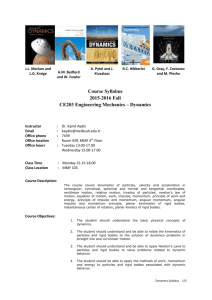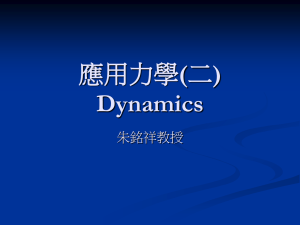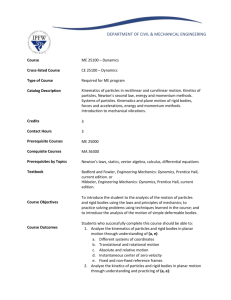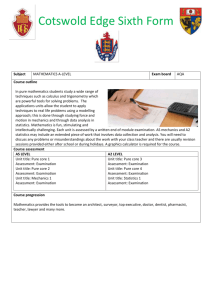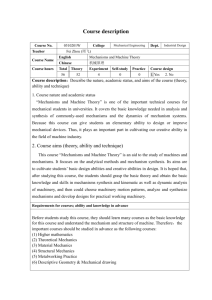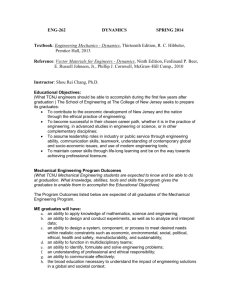التاريخ: 16/9/2007 - Philadelphia University
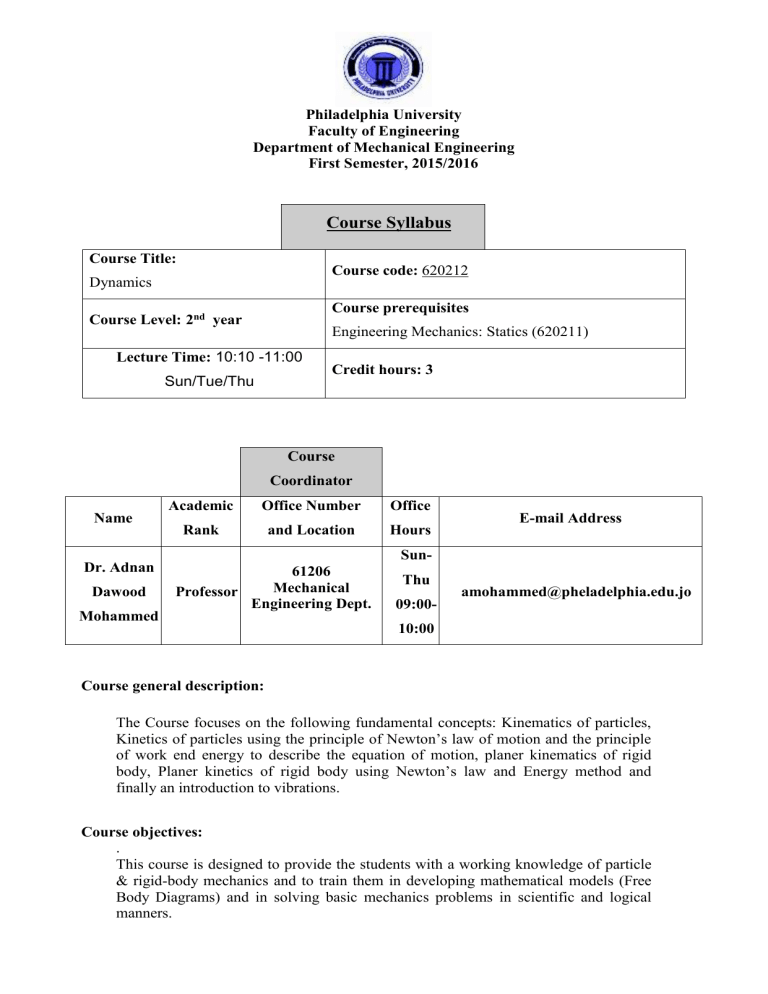
Philadelphia University
Faculty of Engineering
Department of Mechanical Engineering
First Semester, 2015/2016
Course Syllabus
Course Title:
Dynamics
Course code: 620212
Course Level: 2 nd year
Lecture Time: 10:10 -11:00
Sun/Tue/Thu
Credit hours: 3
Course
Coordinator
Name
Academic
Rank
Course prerequisites
Engineering Mechanics: Statics (620211)
Office Number and Location
Office
Hours
E-mail Address
Dr. Adnan
Dawood
Mohammed
Professor
61206
Mechanical
Engineering Dept.
Sun-
Thu
09:00-
10:00 amohammed@pheladelphia.edu.jo
Course general description:
The Course focuses on the following fundamental concepts: Kinematics of particles,
Kinetics of particles using the principle of Newton’s law of motion and the principle of work end energy to describe the equation of motion, planer kinematics of rigid body, Planer kinetics of rigid body using Newton’s law and Energy method and finally an introduction to vibrations.
Course objectives:
.
This course is designed to provide the students with a working knowledge of particle
& rigid-body mechanics and to train them in developing mathematical models (Free
Body Diagrams) and in solving basic mechanics problems in scientific and logical manners.
Course materials:
Text book:
Title: Engineering Mechanics: Dynamics
Author : R. C. Hibbeler
Publisher: Prentice Hall
Edition : 12 th edition, 2009
Support material (s): Lecture notes (soft copy).
Selected solved problems
Homework.
Lectures schedule:
3 hours a week of including a tutorial session of one hour.
Learning outcomes:
1.
Provide the best learning environment and concepts and technical education needed to achieve the above indicated student objectives and for a career in Engineering Technology.
2.
Demonstrate the knowledge and dexterity to perform effectively in the workplace with the communication skills needed to deal with fellow workers, clients and public.
3.
Emphasize the understanding of societal implications of engineering decisions and design in both a local and global context and the ethical training to evaluate those implications.
4.
Encourage class participation, questions and class related discussions.
5.
Incite critical analysis in the solution of problem and application of innovation in technology.
6.
Stimulate team work inside and outside the classroom.
Assessment instruments
Short reports and/ or presentations.
Quizzes.
Home works
Term and final examinations
Allocation of Marks
Assessment Instruments
First examination 20
Mark
Second examination
Final examination: 50 marks
Reports, Quizzes, Home works and attendance of lectures
Total
20
40
20
100
Documentation and academic honesty
Documentation style (with illustrative examples)
Protection by copyright
Avoiding plagiarism.
Course academic calendar
Week No.
(1)
(2)
(3)
(4)
Basic and support material to be covered
-Introduction
-Rectilinear Kinematics: Continuous
Motion
-Tutorial session
-General Curvilinear Motion of Particles
Rectangular Components
-Motion of a Projectile
-Tutorial session
Normal and Tangential Components
Absolute Dependent Motion of Two
Particles
Tutorial session
-Relative motion of two Particles using
Translating axes.
-Tutorial session
(5)
First
Examination
(6)
-Kinetics of Particles – Newton’s Laws
-Equation of Motion: Rectangular
Coordinates, Equation of Motion for a
System of Particles
-Tutorial session
-Equation of Motion: Normal and
Tangential Coordinates
-Tutorial session
(7)
(8)
(9)
(10)
Second
Examination
(11)
(12)
(13)
(14)
(15)
-The Work of a Force
-Principle of Work and Energy
-Principle of Work and Energy for a
System of Particles
-Tutorial sessions
-Conservative Forces and Potential
Energy
-Conservation of Energy
-Tutorial session
Kinematics of rigid bodies: rotation, absolute motion, relative velocity,
-Tutorial session
-Planer Kinematics of rigid bodies: instantaneous center, velocity triangle and acceleration polygon Relative motion analysis, using rotation axes. -
-Tutorial sessions.
Planar Kinetics of rigid bodies
-Moment of inertia, Planar kinetic of motion, Equation of motion translation
-Equation of motion: rotation about
Home works
Selected typical
Problems from the text book
Selected typical
Problems from the text book
Selected typical
Problems from the text book
Selected typical
Problems from the text book
Selected typical
Problems from the text book
Selected typical
Problems from the text book
Selected typical
Problems from the text book
Selected typical
Problems from the text book
Selected typical
Problems from the text book
Selected typical
Problems from the text book
Selected typical
Problems from the text book
(16) fixed axis. Equation of motion: general plane motion.
-Tutorial and problem solving
A Review for all Chapters
Final Examination
Expected workload:
On average students need to spend 2 hours of study and preparation for each one hour lecture/tutorial.
Attendance policy:
Absence from lectures and/or tutorials shall not exceed 15%. Students who exceed the 15% limit without a medical or emergency excuse acceptable to and approved by the Dean of the relevant college/faculty shall not be allowed to take the final examination and shall receive a mark of zero for the course. If the excuse is approved by the Dean, the student shall be considered to have withdrawn from the course.
Course additional references
Books
Engineering Mechanics (Dynamics), By: J. L. Meriam, latest edition.
Vector mechanics for Engineers (Dynamics), By: F. Beer and E. R. Johnston, latest edition.
